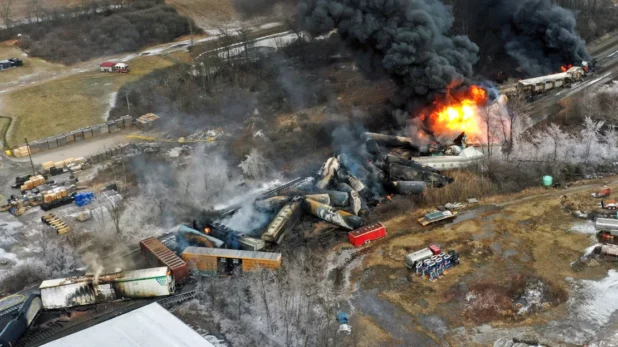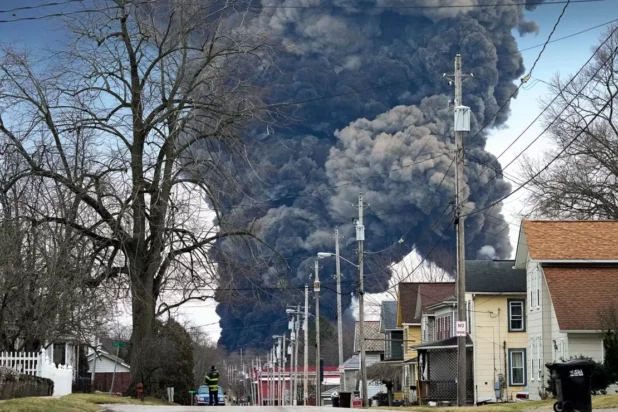🚨 #BREAKING: Biden’s NTSB Chair has just admitted to in a Senate hearing today the “controlled explosion” of the train in East Palestine, Ohio was UNNECESSARY
She says the chemical tank cars had already cooled and stabilized, meaning there was NO risk of an “uncontrolled… pic.twitter.com/Pq3d6Mcox0
— Nick Sortor (@nicksortor) March 6, 2024
Yeah, just live in this toxic waste. It’s fine.
We’ve gotta focus on pizza ovens.
CNN:
When government officials lifted an evacuation order for people who lived near the site of a train derailment and toxic spill in East Palestine, Ohio, last year, many homes held on to an odd odor.
It was a sickly-sweet smell, and it evoked comparisons to paint thinner, but fruitier, or maybe potpourri mixed with old perfume.
To reassure residents, the train’s operator, Norfolk Southern, and the US Environmental Protection Agency offered to check the air in homes for chemicals.
More than 600 households signed up. What they didn’t know was that the handheld devices used for the screening couldn’t detect one of the main chemicals spilled from the train — butyl acrylate — at levels that could irritate the eyes, nose, throat and lungs.
Case studies of people exposed to butyl acrylate in previous spills have raised questions about whether brief exposures may lead to longer-term health problems.
“I would say this is one of the most significant errors associated with the response,” said Dr. Andrew Whelton, an environmental engineer at Purdue University who has done independent testing in East Palestine. “It’s because of this so many people were chemically exposed when they returned.”
Although the EPA and Norfolk Southern’s contractor, CTEH, understood the limitations of the machines, they carried on with the home testing, according to an air testing plan drawn up by CTEH. They relied on smell to pick up on the presence of butyl acrylate at lower levels — although residents weren’t told that odors could indicate chemical exposure, according to an EPA official who answered questions on behalf of the agency on the condition that they not be named.
By the time the EPA adopted a more sensitive test and a lower standard for butyl acrylate, the home screening was nearly complete. People who’d had their homes checked weren’t told about subsequent adjustments to the air testing program and why they were made, according to CTEH and the EPA. They were never offered more indoor air testing.
“I had no idea,” said David Chick, who lives about a quarter of a mile from where the train wrecked and caught fire.
Chick thinks that few people in the village are aware of what happened and that confusing messages from the EPA have probably fueled division and distrust in the community. “The dynamic around town would be completely different if even 60% or 70% of the people knew that,” he said.
Butyl acrylate was one of a stew of toxic chemicals released into the soil, air and local waterways after a Norfolk Southern train flew off its tracks and caught fire on February 3, 2023, damaging at least 11 cars carrying hazardous materials, according to the EPA.
Two of the cars that derailed had been holding nearly 386,000 pounds of acrylates, strong-smelling, highly irritating chemicals that are used to make paints, coatings, caulks and sealants.
Many people know the olfactory assault of acrylates from nail salons, since some types of nail polish and nail products use them.
Two acrylates were spilled in East Palestine: butyl acrylate and ethylhexyl acrylate.
Surface water testing by the Ohio EPA found sky-high levels of acrylates in local creeks in the first few days after the derailment. Those levels tapered off and are undetectable now, based on recent testing, but the chemicals were still detectable in Sulphur Run through March 2023.
It’s not clear how much butyl acrylate people were exposed to or for how long. Environmental health experts note that because of a number of factors, including age and underlying health conditions, there’s a wide range of individual sensitivity to chemicals. In other words, different people will react to chemicals at different levels.
In the first few weeks after the spill, more than 90% of 702 people in the area who answered a government health survey reported having headaches, and more than 70% reported coughing or burning eyes. Stuffy noses, dizziness and breathlessness were also common, as were new or worsening mental health problems.
David and Shanna Chick and their two grade-school-age kids live about a quarter of a mile from where the train wrecked and caught fire. David, 32, has lived in East Palestine his whole life.
They had their home tested when Norfolk Southern and the EPA offered the screening on February 10, 2023. They were told that there was no problem, nothing was detected. CNN reviewed their air screening results.
Shanna, 33, works from home. She says the smells and symptoms aren’t as bad as they were in the beginning, but they still come and go.
“There’re days when I go outside, and I’m just walking to my garage, and I can just feel that I’m having a hard time breathing,” she said.
She wants to believe the EPA’s assurances that her family is out of harm’s way, she says, but her body is telling her something else.
“They’re missing something,” she said.
David is the operations manager for CeramSource, a company that closed one of its East Palestine manufacturing plants — Ceramfab — in 2023, laying off about 30 workers. The derailment and subsequent burn of thousands of pounds of vinyl chloride happened almost directly behind the Ceramfab building.
He said contractors hired by the railroad screened the building with one of the handheld devices, a photoionization detector or PID.
“They gave us the all-clear. They said ‘OK, go back to work. You’re fine,’” he said. Air screening results reviewed by CNN show that Ceramfab was tested on February 11, 2023, and nothing was detected.
Workers came back on a Monday, he said. By Wednesday, they were getting rashes and feeling breathless. One person had a nosebleed.
When they tried to bring the workers back again the next week, “it was the same thing all over again,” he said.
Eventually, Ceramfab’s customers stopped placing orders for fear their products would be contaminated, and Edwin Wang, David’s boss, decided to shut the factory down.
David has spent the past few months trying to get the factory packed up and closed. He says his eyes get irritated, his throat gets scratchy, and it’s harder to breathe after spending time in the building. The EPA is testing Ceramfab for vapor intrusion, or chemicals that might have migrated under the foundation of the building through contaminated soil.
No one will go to prison for this.
🚨Senator @JDVance1 questions Norfolk Southern’s motives for “controlled burn” of toxic chemicals in East Palestine, Ohio:
“A lot of people are wondering: did they do this not because it was necessary, but because it allowed them to move traffic and freight more quickly?” pic.twitter.com/x0ASr450X0
— Senator Vance Press Office (@SenVancePress) March 9, 2024
 Daily Stormer The Most Censored Publication in History
Daily Stormer The Most Censored Publication in History




